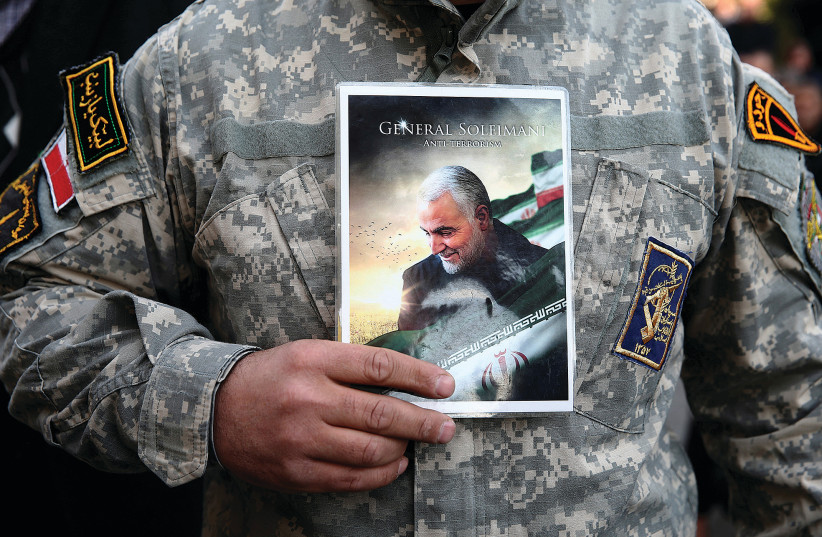Did Soleimani think US might kidnap him on Syria-bound flight? - analysis

It’s not clear if the account is accurate. It is one of those accounts that are designed to come out years after Soleimani was showcased to herald his abilities.
Qasem Soleimani, commander of the Islamic Revolutionary Guard Corps Quds Force who was killed by the United States in January 2020, might once have come perilously close to being intercepted by US forces in Baghdad, Iran’s semi-official Tasnim News Agency reported Sunday.
The story, headlined “If they want to take me to Tel Aviv I will fight to the last bullet,” revolves around a flight Soleimani was on from Iran to Syria that was forced to land in Baghdad.
The Iranian media account claimed this took place “during a period when Americans were [forcibly] landing flights from Iran to Syria in Iraq.”
When did this story take place?
The claim is not completely unfounded. In September 2012 and April 2013, a report said, “Iraqi authorities forced an Iranian cargo plane heading to Syria to land for inspection in Baghdad to ensure it was not carrying weapons, an Iraqi official said.”
The report said Soleimani’s bodyguards were the ones who revealed the story. During the flight, the IRGC leader was not listed on the manifest, so neither the American nor Iraqi authorities knew he was on the plane.
Soleimani played a key role in supporting the Syrian regime during the Syrian civil war, encouraging Russia to intervene. He also played a key role in Iraq in the war against ISIS.
“There was a period when the Americans forced Iran-to-Syria flights [to land] in Iraq and through pressure on the government of this [Iraq] country, and the representative of the Americans came and visited the cargo of the plane and went around the plane and saw the cockpit and passengers,” the report said.
On one flight, Soleimani was on a plane packed full of passengers, the report said, adding: “We were in the middle of the flight when the pilot came and said, ‘They have announced that we have to stay in Iraq.’” The account does not provide a date.
According to the report, a conversation took place among the passengers about whether they should turn around: “In this situation, we were all worried about Haji [Soleimani], and we said that maybe they know that Haji is on the flight and something might happen, and several officials were also on the plane and said, ‘Let’s go back Haji.’ The pilot said, ‘No problem, we say that it is not possible to land and we will return to Iran.’”
Soleimani apparently allowed the pilot to land and was not concerned about the episode, perhaps showcasing his bravery in the face of US threats. The accuracy of the account could not be verified.
How did Soleimani get away?
According to the report, Soleimani then changed into the clothes of a flight engineer.
“The flight landed and the American car came to check the plane’s cargo,” the report said. “At this moment, before the flight engineer went down to open the cargo hold, we suddenly saw Haj Qasem [Soleimani] standing on the stairs at the door of the plane wearing the flight engineer’s uniform and his flight staff card was upside down, but he didn’t care.”
THE COMICAL element here is used to illustrate that he wore the ID of the person’s clothes he had changed into upside down.
“The American soldier came up with some agents and looked at the passengers, and Haji was standing at the door like a flight engineer, doing his job, and constantly looking to see what they were doing, while the security team was sitting on a chair with Haji,” the report said.
If true, it is unclear why the US would have been involved in the search of the plane. The US left Iraq in 2011 and returned in 2014 at Baghdad’s invitation to help fight ISIS.
The account implies that the US was still working closely with Iraqi authorities to interdict flights to Syria that might have been carrying arms. According to the report, as a flight engineer, Soleimani bid goodbye to those who came to search the flight, and no one was the wiser.
“[Soleimani] did not have any worries,” the account said, quoting him as saying that if they had tried to detain him, or if “they want to take us to Tel Aviv or put us in any other country, I will not give up and I will fight to the last bullet.”
This mythological-type story about Soleimani in disguise on a plane being searched is as plausible as it is surprising. Soleimani was known to travel in plainclothes and show up in various countries, including on front lines during the wars in Syria and Iraq. This was part of the legend and myths that blossomed around him.
The story is supposed to illustrate his bravery and how he outwitted the US. It is set in contrast, however, to his successors, who might not have been as interesting or have not been able to carve out any kind of legendary status to inspire the next generation of IRGC members.
Jerusalem Post Store
`; document.getElementById("linkPremium").innerHTML = cont; var divWithLink = document.getElementById("premium-link"); if (divWithLink !== null && divWithLink !== 'undefined') { divWithLink.style.border = "solid 1px #cb0f3e"; divWithLink.style.textAlign = "center"; divWithLink.style.marginBottom = "15px"; divWithLink.style.marginTop = "15px"; divWithLink.style.width = "100%"; divWithLink.style.backgroundColor = "#122952"; divWithLink.style.color = "#ffffff"; divWithLink.style.lineHeight = "1.5"; } } (function (v, i) { });

